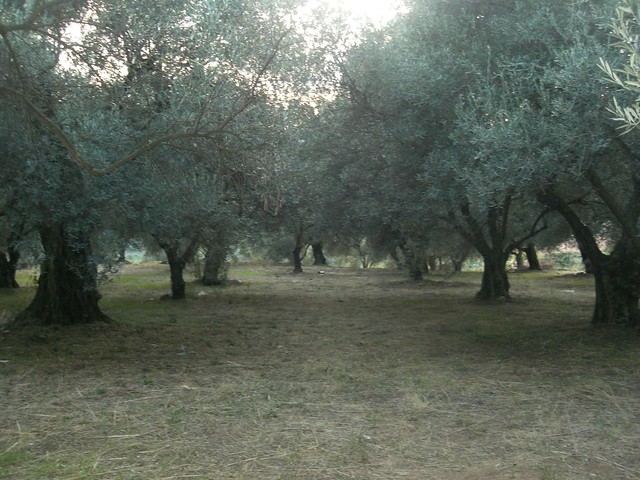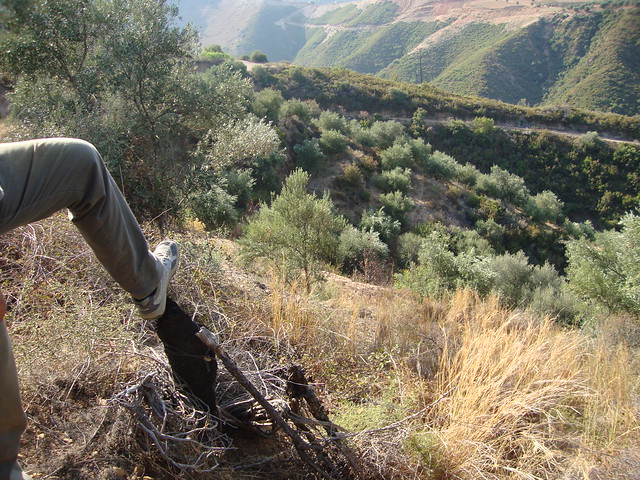Cheesecake in the sense that it is understood in modern culinary terms - a crumbed base, topped by a cream-cheese filling and decorated with fruit or jam - is not very Greek, even though one of the first cheesecakes was probably the 'plakounta' (placenta) made by ancient Greeks. Something similar to the plakounta is the simple melopita (honey pie), made on the island of Sifnos, a self-crusting egg-and-fresh-cheese mixture sweetened with honey. Traditional Greek cooking also includes a lot of sweet cheese-based desserts: in Crete, we have mizithropita (also known as Sfakiani pita) and other similar filo-wrapped pies.
Modern New York style cheesecake is now widely available in Greek patisseries, and is quite popular, possibly due to the heavy advertising of Philadelphia cream cheese, with a whole TV cooking show dedicated to its use. It's not an ingredient I keep in the house because of our preference for locally produced fresh cheeses. I decided to make a cheesecake with my leftover Greek Christmas cookies, melomakarona, which we got a bit tired of eating. For the cream cake, an idea would be to use a recipe for melopita which uses fresh cheese (mizithra). But local mizithra varieties have a distinctly savoury taste, which is why it isn't the best cheese to use when making a no-cook cheesecake. For this reason, I decided to use Philadelphia cream cheese, which gives a smooth texture, mixed with some other Greek dairy products.

For the base:
Break some leftover melomakarona (including crushed walnuts - I think I used about 10 melomakarona) for your base and mix them with about 50g butter. Press this mixture into a baking tin (I don't have a springform tin).
For the cream filling:
Place a small pottle of cream cheese (200g) with equal amounts of thick Greek yoghurt (known in Greece as γιαούρτι στραγγιστό - 'milk cream') and cream (known in Greece as κρέμα γάλακτος - 'milk cream'), 50g runny honey and grated orange zest. Once the mixture thickens (but does not set), pour it over the biscuit base and allow to set in the fridge.
For the topping:
Any kind of jam would do here. I decided to cook up a fresh runny jam, by heating about 100g of frozen red berries with 50g sugar for 5 minutes on high heat. I poured this hot mixture over the cold cream to get a slightly marbled effect. (Alternatively, let the jam cool down for a firmer top layer.)

Modern New York style cheesecake is now widely available in Greek patisseries, and is quite popular, possibly due to the heavy advertising of Philadelphia cream cheese, with a whole TV cooking show dedicated to its use. It's not an ingredient I keep in the house because of our preference for locally produced fresh cheeses. I decided to make a cheesecake with my leftover Greek Christmas cookies, melomakarona, which we got a bit tired of eating. For the cream cake, an idea would be to use a recipe for melopita which uses fresh cheese (mizithra). But local mizithra varieties have a distinctly savoury taste, which is why it isn't the best cheese to use when making a no-cook cheesecake. For this reason, I decided to use Philadelphia cream cheese, which gives a smooth texture, mixed with some other Greek dairy products.

For the base:
Break some leftover melomakarona (including crushed walnuts - I think I used about 10 melomakarona) for your base and mix them with about 50g butter. Press this mixture into a baking tin (I don't have a springform tin).
For the cream filling:
Place a small pottle of cream cheese (200g) with equal amounts of thick Greek yoghurt (known in Greece as γιαούρτι στραγγιστό - 'milk cream') and cream (known in Greece as κρέμα γάλακτος - 'milk cream'), 50g runny honey and grated orange zest. Once the mixture thickens (but does not set), pour it over the biscuit base and allow to set in the fridge.
For the topping:
Any kind of jam would do here. I decided to cook up a fresh runny jam, by heating about 100g of frozen red berries with 50g sugar for 5 minutes on high heat. I poured this hot mixture over the cold cream to get a slightly marbled effect. (Alternatively, let the jam cool down for a firmer top layer.)

Another Greek idea for topping would be to pour some honey over the cream, sprinkled with orange zest and ground cinnamon, something I decided against at the last minute, because I was fast running out of honey after all my Christmas baking. honey also has a very sharp taste, whereas sugar is more neutral (it sweetens something without adding flavour to it, like honey does).
It's now St John's feastday, and there are still some more melomakarona (as well as kourambiedes) left over. An idea for a trifle, perhaps?
©All Rights Reserved/Organically cooked. No part of this blog may be reproduced and/or copied by any means without prior consent from Maria Verivaki.




















































